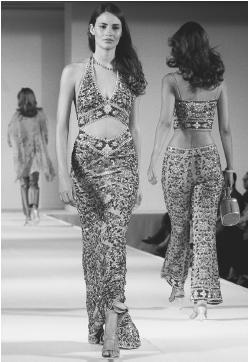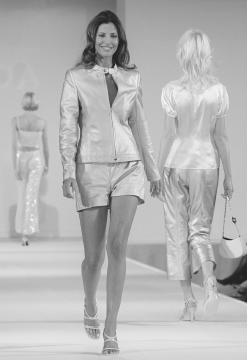ESCADA - Fashion Designer Encyclopedia
German fashion house
Founded: by Wolfgang and Margarethe Ley (died 1992) in Munich, 1976. Company History: Expanded throughout Germany, then into U.S., 1982; company went public, 1986; began opening retail stores

Publications
On ESCADA:
Articles
Shiro, Anne-Marie, "Black Ties Come Out to Herald a New Boutique (Escada in New York)," in the New York Times, 24 November 1991.
Agins, Teri, "Despite the Recession, High Fashion Escada Expands World-Wide," in the Wall Street Journal, 15 April 1992.
"Swede Success," in Woman's Journal (London), May 1992.
"Margarethe Ley, Cofounder of Escada AG Dead at 56," in WWD, 8June 1992.
Shiro, Anne-Marie, "Margaretha Ley, Sportswear Designer and Merchant, Dies," in the New York Times, 9 June 1992.
Geran, Monica, "Escada (Design of New York Flagship Store)," in Interior Design, July 1992.
White, Constance C.R., "Escada Evolves," in WWD, 4 November 1992.
Drier, Melissa, "Escada Sport: Going Casual," in WWD, 2 March 1994.
Lender, Heidi, "Escada's New Era," in WWD, 21 December 1994.
Spindler, Amy, "Eyes on Escada," in the New York Times, 10 January 1995.
Aykroyd, Bettina, "Escada Beauté: Growth Through Acquisition and Innovation," in Soap & Cosmetics Specialties, January 1998.
Manan, Dazman, "Escada Finds Sweet Success," in the New Straits Times, 6 May 1999.
Rubenstein, Hal, "The Look of Escada," in In Style, 1 January 2001.
"Fascinating Escada," in Siagon Times Magazine, 30 September 2001.

***
The Escada group was founded in 1976 near Munich, Germany, by Wolfgang and Margarethe Ley. The company took its name from an Irish thoroughbred racehorse and both Leys were betting on their enterprise to win. The group designs, produces, and distributes high quality women's fashion, marketed worldwide to leading fashion stores and proprietary boutiques. Apart from Escada by Margarethe Ley, which included apparel, luggage, fragrance, and accessories, the group's other labels have included Cerruti 1881, Crisca, Kemper, Laurel, Apriori, Seasons, Natalie Acatrini, Marie Gray, Schneberger, and St. John (sold in 1993).
Margarethe Ley was the chief designer for the group until her death in 1992. She strongly adhered to the belief that a designer must never rely solely on creative talent to be a success; creativity must be balanced by a strong market appeal. Ley created a highly distinctive identity for Escada—clean, slick, and sophisticated. She also pioneered the development of exiciting new fabric combinations and color schemes when so many other designers were solidly into black.
When Ley died, she was succeeded by Michael Stolzenburg who brought a younger, more modern perspective to the company. Taking his influence from daily life, he believed the balance of a collection relied on the mix of tried and true design and fresh new ideas. He was backed by a strong team of designers, chiefly from British and German fashion schools. During this time Escada also spearheaded an unusual fragrance turn, producing the company's first "seasonal" scent. The earliest concoction, Chiffon Sorbet, was a summer fragrance and had been marketed only through the summer months in 1993. The seasonal gambit garnered attention, yet 1994 brought the untimely death of Stolzenburg. The firm turned to Todd Oldham to serve as the company's creative consultant in 1994, the same year Escada Sport was launched. Oldham's creations were enthusiastically received, and in 1995 both Escada Knit and Classic Elements became available in the company's wide spectrum of colors and fabrics.
In the late 1990s Escada launched an eyewear collection with Airess, its first major licensing deal, then followed with a slew of accessories including jewelry, lingerie, shoes, scarves, and ties. New fragrances, both traditional and the experimental seasonal scents, were also introduced including the Escada Sport trio ( Sport Spirit, Feeling Free, and Country Weekend, 1997), En Fleur (1997, and later brought out in a compact design in 1999), Casual Friday (1999), Loving Bouquet (a seasonal installment, 1999), and Sentiment (2001).
In the early 2000s Escada had over 375 boutiques worldwide, including new boutiques in Paris and Kuala Lumpur, and was relocating its New York flagship store to larger digs on Fifth Avenue. The luxury retailer was considered the world's largest ready-to-wear producer with some 1,500 different styles available each year, and to increase its marketshare further, Escada entered into a joint venture in the summer of 2001 with the SECON Group, each buying a 45-percent stake in Louis Féraud. The entrepreneurial spirit of founders Wolfgang and Margarethe Ley is alive and well in the enduring success of Escada.
—KevinAlmond;
updated by NellyRhodes
Comment about this article, ask questions, or add new information about this topic: